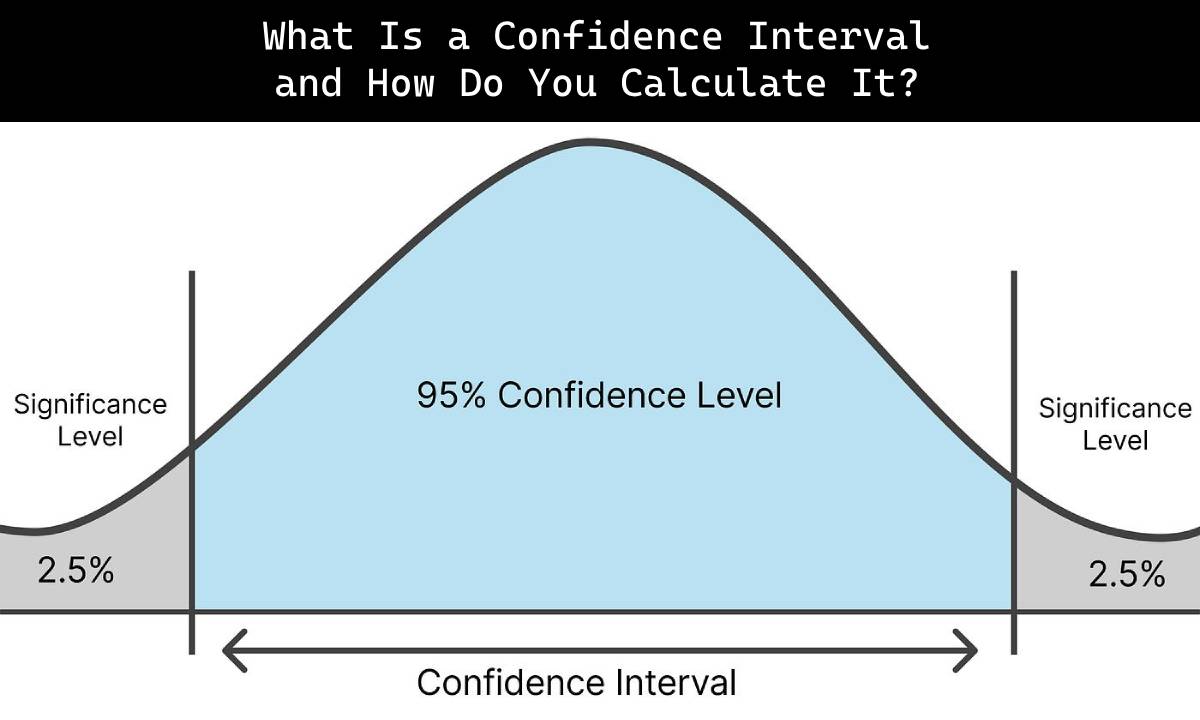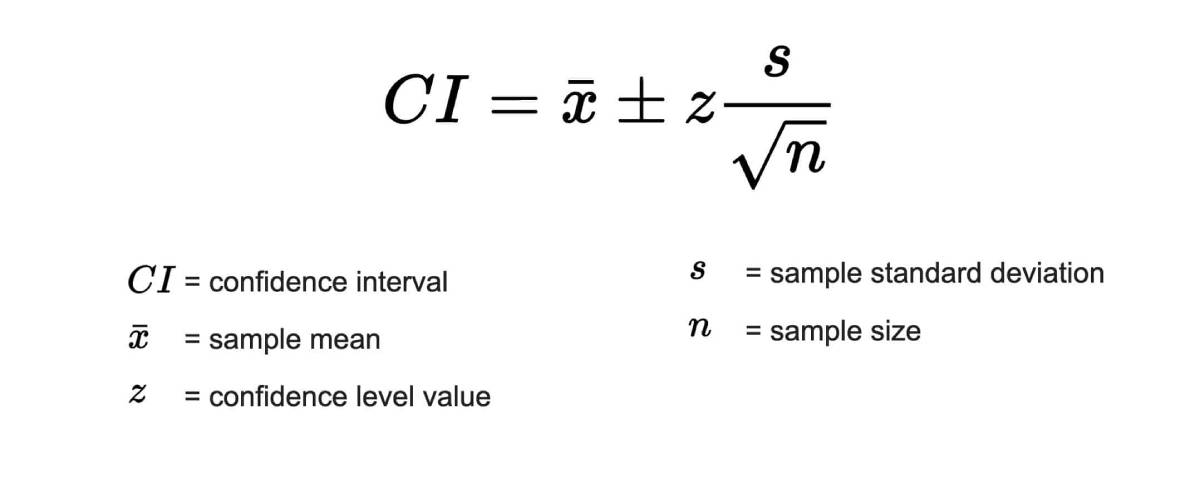Confidence intervals help in assessing populace boundaries from test information, pivotal in measurable examination for specialists and experts. A certainty span is a reach where the genuine boundary is probably going to be found, with certainty.
Envision you’re attempting to gauge the typical level of all understudies in a school in light of an example of understudies. A certainty stretch would provide you with a scope of levels inside which you’re sure the genuine normal level falsehoods. This measurable idea assumes a significant part in dynamic cycles across different fields, from clinical examination to business examination.
Confidence spans gauge populace boundaries from test information, fundamental in the factual examination for specialists and experts. Let’s delve deeper into what confidence intervals entail and how they’re calculated.
Understanding Confidence Intervals
Confidence intervals are vital in statistics, offering a range for estimating the true population parameter reasonably.
These intervals offer valuable insights into the variability and uncertainty inherent in sample data, guiding decision-making processes across diverse fields. Let’s delve into the intricacies of confidence intervals to grasp their significance in statistical analysis.
See Also: Data and Analytics Modernization: The Definitive Guide
Definition of Confidence Intervals
A confidence interval is a factual reach that communicates the vulnerability related to assessing a populace boundary in light of test information. It comprises an upper and lower bound inside which the genuine boundary is accepted to lie with a specific degree of certainty.
For example, assuming we gauge the mean level of a populace to be somewhere in the range of 65 and 75 creeps with a 95% confidence span, we are 95% sure that the genuine populace means falls inside this reach.
Purpose of Confidence Intervals in Statistical Analysis
Confidence intervals serve a vital job in factual examination by giving a proportion of the accuracy and dependability of evaluations.
They permit scientists and investigators to survey the vulnerability encompassing a specific measurement and go with informed choices in light of the scope of conceivable qualities.
Whether assessing populace means, extents, or different boundaries, confidence intervals offer a complete comprehension of the fluctuation inborn in example information.
Why Confidence Intervals are Preferred Over Point Estimates
Unlike single-point gauges, confidence intervals convey the full scope of conceivable qualities for a populace boundary, considering fluctuation and vulnerability.
This nuanced approach upgrades the legitimacy and power of factual derivations, empowering examiners to impart the dependability of their discoveries.
By embracing confidence spans, scientists can make more precise and solid ends, encouraging more prominent trust in factual examinations.
Key Components of a Confidence Interval
Understanding the vital parts of a confidence interval is fundamental for getting a handle on the subtleties of measurable assessment.
Every part assumes an essential part in characterizing the scope of values inside which we can sensibly gauge the genuine populace boundary.
We should investigate these parts exhaustively to acquire a more profound comprehension of how confidence spans are built and deciphered.
Point Estimate
The point estimate serves as the central value around which the confidence interval is constructed. It represents our best guess or estimate of the population parameter based on sample data.
For example, if we’re assessing the mean level of a populace, the point gauge would be the example mean level determined from the information.
While the point gauge offers a solitary benefit for the boundary, it doesn’t convey the vulnerability related to the gauge. In this manner, it’s vital to supplement the point gauge with a proportion of fluctuation, like the confidence interval, to catch the full scope of conceivable qualities.
Margin of Error
The room for mistakes evaluates the accuracy of the point gauge by giving a proportion of the vulnerability encompassing it. It addresses the greatest sum by which the point gauge might go astray from the genuine populace boundary.
A more modest safety buffer shows more prominent accuracy in the gauge, while a bigger wiggle room recommends more prominent vulnerability.
The room for mistakes is affected by elements, for example, test size and fluctuation in the information, with bigger example sizes and lower changeability normally bringing about more modest safety buffers.
Confidence Level
The confidence levels address the degree of conviction or unwavering quality related to the confidence levels. It shows the likelihood that the stretch contains the genuine populace boundary. Normally utilized confidence levels incorporate 90%, 95%, and close to 100%, with higher confidence levels relating to more extensive stretches.
For example, a 95% confidence level infers that if we somehow happened to build various certainty stretches from various examples, roughly 95% of these intervals would contain the genuine populace boundary. The decision of confidence levels relies upon the ideal degree of conviction and the compromise between accuracy and unwavering quality in the assessment cycle.
Calculating Confidence Intervals
Exploring the domain of statistics frequently includes figuring out the complexities of working out confidence intervals, a basic part of measurable investigation.
Whether assessing populace boundaries or making deductions from test information, confidence spans give significant bits of knowledge into the vulnerability encompassing measurable appraisals.
We should dig into the most common way of ascertaining confidence intervals to reveal the means in question and their importance in measurable deduction.
Overview of the Formula
Calculating a confidence interval commonly includes applying a recipe that records for the example insights, for example, the example mean or extent, alongside proportions of inconstancy and the ideal degree of confidence.
The equation changes relying upon the boundary being assessed and the qualities of the information, yet it by and large involves joining the guide gauge with room for mistakes toward characterizing the interval.
Steps Involved in Calculating Confidence Intervals
The method involved with confidence spans normally follows a few key stages. In the first place, we register the point gauge from the sample data, for example, the sample mean or extent. Then, we decide the margin of error and take given variables, for example, test size and changeability.
At last, we build the confidence interval by consolidating the point gauge with the room for mistakes, bringing about a scope of conceivable qualities for the populace boundary.
Understanding the Significance of Each Step
Each move toward the computation interaction adds to the general precision and unwavering quality of the confidence interval.
The point gauge surmises the populace boundary, while the room for mistakes measures encompassing vulnerability.
By understanding the meaning of each step, experts can arrive at informed conclusions about the legitimacy and accuracy of their measurable evaluations, guaranteeing strong and dependable ends.
Interpreting Confidence Intervals
Understanding how to decipher confidence spans is vital for making significant determinations from factual investigations. confidence intervals offer bits of knowledge into conceivable populace boundary values, uncovering inborn assessment uncertainty.
How about we investigate the subtleties of deciphering confidence intervals to gather significant bits of knowledge from measurable discoveries?
How to Interpret the Results of a Confidence Interval
Interpreting the consequences of a confidence interval includes considering both the point gauge and the stretch width.
The point gauge is the most realistic estimation of the populace boundary, while the interval width shows conceivable qualities. Investigators should evaluate whether the stretch contains significant qualities and consider the ramifications of uncertainty when deciphering the outcomes.
What the Interval Width Signifies
The width of a confidence interval signifies the precision and reliability of the estimate. A narrower interval indicates greater precision, suggesting a more accurate estimate of the population parameter. Conversely, a wider interval suggests increased uncertainty and less precise estimation.
Analysts should carefully examine the interval width to gauge the reliability of the estimate and assess the level of uncertainty associated with the findings.
Making Conclusions Based on Confidence spans
Making conclusions based on confidence intervals requires considering both the interval width and the confidence level. Analysts must balance precision and confidence, considering a narrower interval against sufficient reliability in their calculations.
Additionally, they ought to decipher the outcomes concerning the exploration question and make significant determinations that record the vulnerability innate in the assessment cycle. Via cautiously deciphering confidence spans, experts can settle on educated choices and convey the unwavering quality regarding their discoveries.
See Also: Predictive Analytics for Informed Decision-Making
Common Mistakes to Avoid
In the domain of statistical analysis, understanding and accurately deciphering confidence intervals is principal. Be that as it may, a few normal slip-ups can subvert the legitimacy and dependability of these stretches whenever left unrestrained.
By perceiving and keeping away from these traps, experts can guarantee the exactness and heartiness of their measurable decisions.
Misinterpreting the Confidence Level
Perhaps the most predominant error in deciphering confidence intervals is misconstruing the confidence level. The confidence level addresses the likelihood that the stretch contains the genuine populace boundary. In any case, it doesn’t show the likelihood that a particular stretch built from a specific example contains the boundary.
Confusing the confidence level can prompt wrong decisions about the accuracy and dependability of the gauge. Investigators should comprehend that the confidence level mirrors the drawn-out exhibition of the assessment technique as opposed to the probability that a particular stretch contains the genuine boundary.
Misusing the Margin of Error
Another common mistake is abusing the margin of error, which evaluates the accuracy of the gauge. Investigators may incorrectly decipher the room for give and take as a proportion of inconstancy or use it to look at gauges from changed examples.
Notwithstanding, the room for mistakes just applies to the particular gauge within reach and can’t be summed up across various examples or boundaries. Abusing the margin of error can prompt mistaken decisions about the exactness and unwavering quality of the gauge.
Incorrectly Applying the Formula
Lastly, incorrectly applying the formula for calculating confidence intervals can result in inaccurate estimates and erroneous conclusions. Analysts may overlook critical assumptions or misinterpret the requirements of the formula, leading to flawed interval construction.
It’s essential to carefully follow the correct procedure for calculating confidence intervals, ensuring that all assumptions are met and that the formula is applied correctly to produce valid and reliable results.
By avoiding these common mistakes, analysts can enhance the integrity and validity of their statistical analyses and draw accurate conclusions from confidence intervals.
Practical Tips for Calculating Confidence Intervals
Calculating confidence intervals can be daunting, but practical tips streamline the process and improve accuracy. By leveraging statistical software or calculators, ensuring accuracy in calculations, and checking assumptions before computing intervals, analysts can optimize the reliability and validity of their statistical inferences.
Utilizing Statistical Software or Calculators
One of the most productive ways of computing confidence intervals is by using particular measurable programming or online adding machines. These tools mechanize the calculation cycle, decreasing the probability of mistakes and assisting the investigation.
By inputting relevant data and specifying the desired confidence level, analysts can generate precise confidence intervals with minimal effort. R, Python, and SPSS include built-in functions for confidence intervals; online calculators offer quick estimation alternatives.
See Also: Choosing A Database for Machine Learning
Ensuring Accuracy in Calculations
Precision is vital while computing confidence intervals, as even minor blunders can altogether affect the legitimacy of the appraisals. Examiners ought to twofold really take a look at their estimations and confirm contributions to guarantee consistency and accuracy.
Scrupulousness and examination of each move toward the estimation cycle are fundamental for creating dependable outcomes. By fastidiously investigating estimations and cross-referring to results, experts can alleviate the gamble of errors and improve the honesty of their confidence intervals.
Checking Assumptions Before Calculating
Before setting out the calculation of confidence intervals, investigators should evaluate whether fundamental suppositions are met. These assumptions might incorporate the ordinariness of the information, autonomy of perceptions, and homogeneity of differences.
Deviations from these suppositions can think twice about the legitimacy of the stretch gauges and lead to wrong ends. In this way, directing fundamental checks and addressing any infringement or errors before continuing with the calculation is significant.
By guaranteeing adherence to suspicions, experts can keep up with the respectability and dependability of their confidence intervals, cultivating trust in the subsequent factual deductions.
Conclusion
In conclusion, understanding what a confidence interval is and how to work out it is fundamental for anybody engaged with factual examination. All through this conversation, we’ve investigated the meaning of confidence spans, its key parts, and the means engaged with their estimation.
We’ve underlined the significance of deciphering confidence spans accurately, taking into account factors, for example, the confidence level, margin of error, and interval width. Dominating the idea of confidence intervals permits examiners to pursue informed choices, make dependable determinations, and convey the vulnerability intrinsic in measurable gauges successfully.
As you proceed with your excursion in the measurable examination, I urge you to investigate further uses of confidence intervals and dig further into the subtleties of their understanding. By extending your insight and leveling up your abilities around here, you’ll be better prepared to handle complex information examination challenges with confidence.
If you found this data accommodating, go ahead and it with your companions and partners. Furthermore, make sure to leave your criticism in the remarks beneath – we’d very much want to hear from you!










